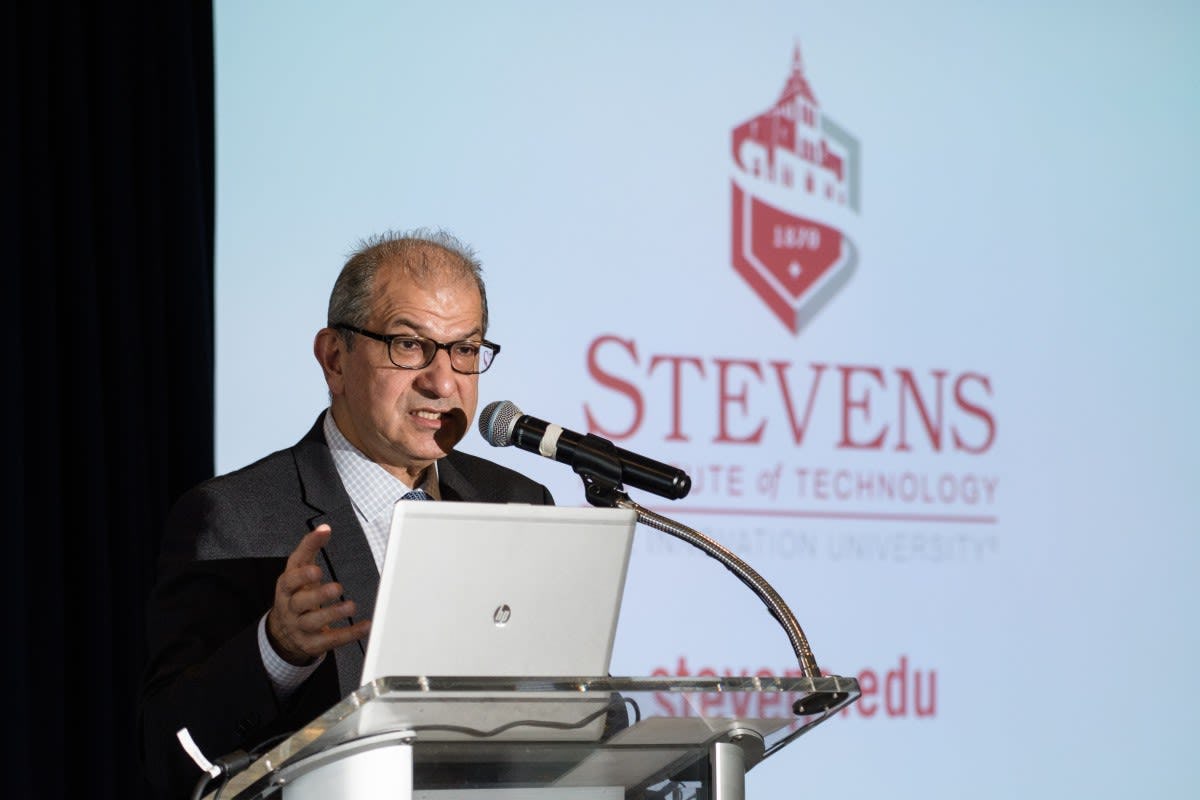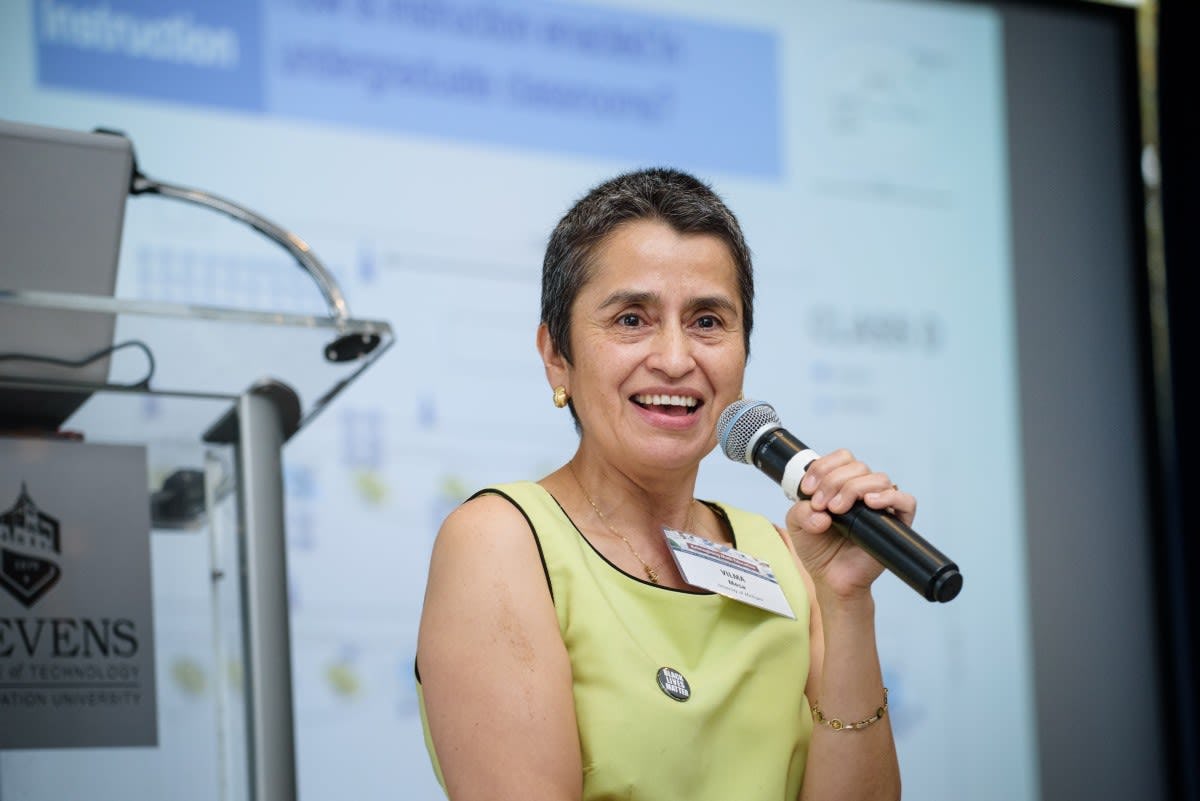Stevens' Conference Aims to be a Game-Changer in Reimagining Math Education
Revamped conference sheds light on the importance of active learning in math education
Earlier this month, Stevens Institute of Technology's Reimagining Math Education conference helped educators find new ways to incorporate innovative, even fun, active learning methods into their classrooms.
Equally important, it showed educators that implementing these proven methods is not only the right thing to do for today’s math learners, but also the best way to raise up tomorrow’s math leaders.
Hosted by Stevens' Department of Mathematical Sciences and organized by teaching assistant professor Jan Cannizzo and teaching associate professors Denis Serbin and Alexey Myasnikov, the conference is part of the department’s ongoing efforts to help high school and collegiate educators teach math more effectively.
"We talked about the educators' use of active learning, and their belief in its effectiveness," Cannizzo says. "Interestingly, even though most of them used these techniques, there was some uncertainty around whether they really improve student understanding."
And that ambiguity may be one of the biggest hurdles to improving math education.
"That’s why we have such a conference," Serbin says. "You have to convince people why this works."
Reimagining the practice of math education
Now in its third year, the conference—which previously focused on calculus—evolved and expanded to encompass the whole spectrum of math education.
"We had slightly more participants than last year, from a wider geographic area," Cannizzo says. "It was a really nice mix, almost evenly split among high school, community college and college educators."
"It seems like we had a lot of people who were here last year," Serbin says. "They came again—and they brought friends."
More importantly, the expanded scope of the conference allowed it to greater efficacy than ever before.
"The Reimagining Math Education conference serves a critical purpose, bringing pioneering and dedicated mathematics educators together to learn, to collaborate, and to advance the state of the art in mathematics education," said President Nariman Farvardin. "Math is not only a basic literacy for effective 21st century citizenship, it’s essential to so many fields that will define our future—such as artificial intelligence and machine learning. Therefore, efforts such as the Reimagining Math Education conference, which ultimately help more students persist and succeed in mathematics courses, are essential."
"We were excited to have Stevens President Nariman Farvardin speak at the conference," Cannizzo says. "We also were pleased to welcome Vilma Mesa, associate professor of education and faculty associate at the University of Michigan, and Jim Fowler, assistant professor in the department of math at Ohio State University."
"In the past decade, there has been increased interest in creating learning environments in undergraduate mathematics that challenge students and faculty into thinking about the subject in a broader way—not just as the application of rote processes," says Mesa. "There is mounting evidence that using class time to have students discuss challenging problems, work in groups or think and discuss questions really benefits them in their learning of the material and their performance in their course. Incorporating them into classrooms more and more mathematics classrooms, at any level, would bring important changes in student perceptions about the value of mathematics for their work and life. That's why conferences like Reimagining Math Education are so important, because they bring together K-12, community college and four-year college educators to re-imagine their practice."
"Often teaching is seen as what happens in the classroom," Fowler notes, "but the Reimagining Math Education conference reminds us that teaching is the combined effort of the whole community of educators and includes the discussions and planning we do outside of the classroom to ensure that the student experience is as effective as possible."
"When everyone is a participant, learning feels like play."
This year, the conference gave attendees more opportunities to get involved, with activities such as an open discussion around topics requested at registration, and math puzzles that offered live polling software for participants to submit their answers.
"We want to practice what we preach, and it felt silly to talk about interactivity in the classroom, but not do it," Cannizzo says. "We gave them problems that were fun, and that they could use in their own classrooms."
"In one puzzle, people had to think about which way a bike would move with a string tied around it. I used my own bike with a string tied around the right pedal as a visual aid," Cannizzo adds. "We also used the clicker method we utilize in our calculus courses. Participants submitted their answers using polling software, and when results were mixed people discussed their answers at their table and answered the question again. It was cool to demonstrate a method we use in the classroom here at Stevens—and it got the participants talking and thinking about math."
Many of the speakers also delivered interactive presentations. "Classrooms must support students in developing 21st century skills including critical thinking, empathy, and creativity," C. Ross Flatt, director of programs and partnership, Institute of Play, told the audience as part of a presentation that included a competition featuring the age-old rock—paper—scissors game. "When everyone is a participant, learning feels like play."
"We had a great response, with lots of happy faces," Serbin says.
Supporting active learning across the board
Even more than the actual active learning techniques shared, the most valuable outcome of the conference may well be its powerful proof that these methods truly work.
"We understand that both students and teachers can be resistant to active learning, because it’s different, and it's more work," Cannizzo says. "But everyone needs to understand it improves learning. Research paper after research paper shows active learning does work. Professor Mesa shared concrete data from the National Science Foundation that supports that fact, and I think we need more of this kind of research data to convince people."
Cannizzo, Serbin and Myasnikov are excited about opportunities to continue these discussions.
"I'd like to have research topics, or speakers who research education," Serbin says, "to go deeper and show data and patterns supporting why these methods work."
"I spoke with a high school teacher from New Hampshire," Cannizzo says. "I talked with someone from Rutgers who was here because she’d heard about all the things we’ve done with calculus and wanted to learn from us because Rutgers is redoing its approach to calculus. An educator from Missouri asked me questions about our calculus system, specifically our system of half-semester modules, because his university is thinking of implementing a similar system."
"This approach to math education is working. And I think this conference has helped make a name for it—and Stevens—as we help spread the word."








